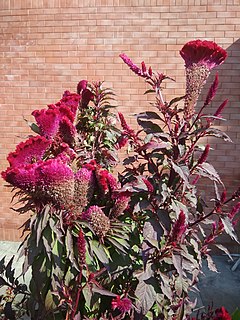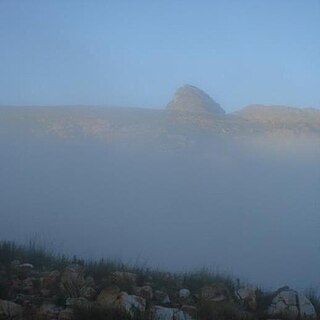This page is based on this
Wikipedia article Text is available under the
CC BY-SA 4.0 license; additional terms may apply.
Images, videos and audio are available under their respective licenses.

The Maya Mountains are a mountain range located in Belize and eastern Guatemala, in Central America.

The Amaranthoideae are a subfamily of the Amaranthaceae. The stamens have anthers with two lobes (locules) and four pollen sacs.
The main distribution of the subfamily is in tropical America, in tropical and Southern Africa, and in Australia.

Fasciation, also known as cresting, is a relatively rare condition of abnormal growth in vascular plants in which the apical meristem, which normally is concentrated around a single point and produces approximately cylindrical tissue, instead becomes elongated perpendicularly to the direction of growth, thus producing flattened, ribbon-like, crested, or elaborately contorted, tissue. Fasciation may also cause plant parts to increase in weight and volume in some instances. The phenomenon may occur in the stem, root, fruit, or flower head. Some plants are grown and prized aesthetically for their development of fasciation. Any occurrence of fasciation has several possible causes, including hormonal, genetic, bacterial, fungal, viral and environmental causes.

Celosia argentea, commonly known as the plumed cockscomb or silver cock's comb, is a herbaceous plant of tropical origin, and is known for its very bright colors. In India and China it is known as a troublesome weed.
Celosia palmeri, commonly known as Palmer's cockscomb, is a species of flowering plant in the amaranth family, Amaranthaceae, that is native to the lower Rio Grande Valley of Texas in the United States as well as northeastern Mexico. The specific name honours British botanist Edward Palmer (1829-1911), who collected the type specimen in Monclova Municipality, Coahuila in 1880. It is a perennial shrub reaching a height of 0.3–1 m (0.98–3.28 ft). Flowering takes place from summer to winter.
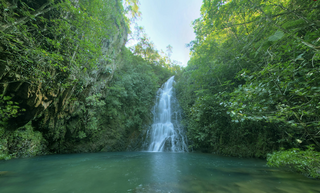
The Cockscomb Basin Wildlife Sanctuary is a nature reserve in the Stann Creek District of south-central Belize. It was established to protect the forests, fauna and watersheds of an approximately 400 square kilometres (150 sq mi) area of the eastern slopes of the Maya Mountains.
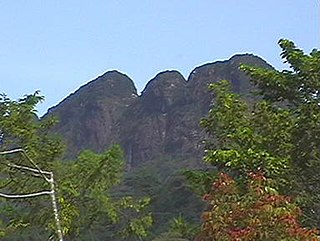
Victoria Peak within the Maya Mountains is the second highest mountain in Belize. The highest peak in the country, Doyle's Delight at a height of 1,124 metres (3,688 ft), is located 57 kilometres (35 mi) southwest of Victoria Peak. Victoria Peak is situated in the Cockscomb Basin Wildlife Sanctuary. Victoria Peak is situated in the Stann Creek District of Belize, in the Cockscomb Basin Wildlife Sanctuary, and is home to many flora and fauna common to Belize.
It was pronounced a natural monument in 1998, comprising about 4,847 acres bordered by the Sittee River Forest Reserve, Cockscomb Basin Wildlife Sanctuary, and Chiquibul National Park.

The Basan (波山), alternatively referred to as Basabasa (婆娑婆娑) or Inuhōō (犬鳳凰), is a fowl-like bird with origins stemming from Japanese mythology and folklore and illustrated in Takehara Shunsen's Ehon Hyaku Monogatari and the Gazu Hyakki Yagyō.
Cockscomb Pass is a mountain pass in the central Baffin Mountains, Nunavut, Canada.

Cockscomb Mountain was named in 1921 because the outline of the summit was said to resemble a roosters comb. It is located in the Sawback Range in Alberta.
Texana denotes both the history and culture of Texas. It may also refer to:

Celosia argentea var. cristata, known as cockscomb, is the cristate or crested variety of the species Celosia argentea. It was likely originally native to India, where it was saved from extinction in cultivation by the religious significance and superstitions attached to the variety by Indian, Burmese, and Chinese gardeners who planted it near temples. The somatic chromosome number for the cristate variety is 2n = 36, while investigation of the typical species revealed a chromosome number of 2n = 72.
Celosia whitei, is a species of flowering plant in the amaranth family, Amaranthaceae. It was described in 1961 by William F. Grant, as Celosia whiteii. The plant was named in honor of Orland E. White.
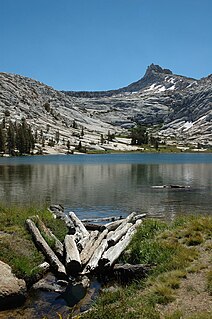
Cockscomb is a mountain, in the area of Tuolumne Meadows, Yosemite National Park, California.

